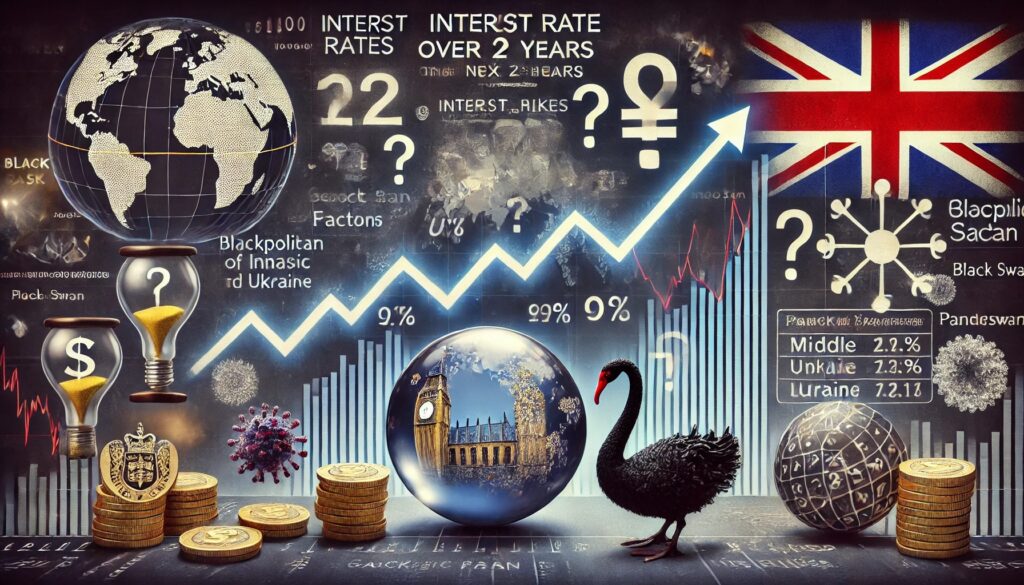
As we progress through 2024, the UK economic outlook remains unpredictable, largely shaped by the Bank of England’s (BoE) efforts to control inflation. After several consecutive interest rate hikes, the base rate currently stands at 5.25%, significantly higher than the near-zero rates seen during the pandemic. The BoE’s primary goal has been to tackle inflation, which, while declining from its peak above 10%, remains elevated around 5%, well above the 2% target. This has left many speculating about the future of UK interest rates, but as we know, predicting such movements can be as speculative as reading a crystal ball.
While there are indications of what the BoE might do in the coming months, numerous variables—both domestic and global—make precise forecasting difficult. From geopolitical tensions to unforeseen economic shocks, much could still shift the landscape in unexpected ways.
The Challenge of Predicting Interest Rates
Forecasting interest rates over the next two years is no easy task, and even respected economists tread cautiously. Andrew Bailey, Governor of the Bank of England, recently acknowledged the uncertainty, stating: “The path of monetary policy is not set in stone. It will depend heavily on the data we see in the coming months and how the broader economy responds.”
Indeed, the global economic environment is fragile. The ongoing conflicts in Ukraine and the Middle East continue to present risks that could dramatically impact global energy prices, inflation, and economic stability. If either conflict escalates or leads to more severe supply chain disruptions, the BoE may be forced to reassess its approach. Additionally, any resolution or de-escalation of these conflicts could alleviate inflationary pressures and give the central bank room to ease rates earlier than anticipated.
It’s worth remembering how unforeseen events—sometimes referred to as “black swan” events—have historically disrupted markets. The Covid-19 pandemic was one such event, reshaping economies overnight. If we were to experience another unexpected crisis, such as a major global health event or financial meltdown, it could radically alter interest rate expectations. As former BoE policymaker Gertjan Vlieghe remarked: “Economic shocks are by their nature unpredictable, and monetary policy must be flexible enough to adapt to them.”
The Forecast for 2025: A Period of Caution
Looking into 2025, many financial experts predict that interest rates will remain elevated for the time being, with the BoE focusing on stabilising inflation. The base rate could peak at around 5.5% by the end of 2024, but beyond that, the picture becomes less clear. If inflation begins to fall more consistently, the central bank may be able to pause its rate hikes or even begin lowering rates in late 2025.
However, even this prediction comes with significant caveats. The Bank of England’s decision-making will be heavily influenced by inflation data and broader economic indicators such as employment rates and GDP growth. Currently, the UK economy is facing headwinds, with some signs of slowing growth, further complicating the BoE’s balancing act between controlling inflation and avoiding a recession.
What Could Go Wrong?
The risk of an unexpected global event—whether political, economic, or environmental—remains a significant factor that could upend any forecast. Should the Middle East conflict or the war in Ukraine escalate, for example, energy prices could soar again, sending inflation rates higher and forcing the BoE to rethink its approach. Conversely, a breakthrough in peace negotiations could ease inflationary pressures and allow the central bank to reduce rates more quickly.
Moreover, there’s always the possibility of another “black swan” event—something as disruptive as the Covid-19 pandemic, which would throw the economy into chaos and force the BoE to take emergency actions. Policymakers are fully aware of this risk. As Andrew Bailey has pointed out: “The world is full of uncertainty. What we do know is that flexibility in monetary policy is essential to responding to such events when they occur.”
Housing Market and Mortgage Holders
For homeowners and property investors, the rising interest rates have already made a substantial impact. Those on variable-rate mortgages or who need to remortgage soon are likely to face higher monthly repayments. As a result, the property market is expected to cool down, with some analysts forecasting a 3-5% drop in UK house prices over the next year. For investors with access to cash or significant equity, this could present opportunities, but for those dependent on financing, higher borrowing costs could create tighter margins.
Long-Term Interest Rate Outlook
Looking further ahead to 2026, the general expectation is that interest rates will begin to fall as inflation comes under control. The BoE might reduce rates to around 3-4% by late 2026 if the economy stabilises and inflation falls back to target levels. That said, this is by no means guaranteed, and as we’ve discussed, much will depend on how the global and domestic economic situation evolves.
Implications for Investors and Savers
For savers, the higher interest rates are offering more attractive returns on savings accounts and bonds, a welcome relief after years of ultra-low rates. This trend is likely to continue into 2025, especially as inflation remains elevated.
For property investors, the current climate demands careful consideration. While house prices may soften due to high mortgage rates, potential buyers will need to balance the benefits of potentially lower prices against the cost of borrowing.
Conclusion: Uncertainty and Opportunity
In summary, while it’s possible to make educated guesses about the future direction of interest rates, the reality is that many factors—both known and unknown—could influence the Bank of England’s decisions. The next two years will likely be characterised by caution as the BoE navigates its dual mandate of controlling inflation and supporting economic growth.
For now, homeowners, investors, and savers should keep a close eye on economic indicators and remain flexible in their financial planning. As former BoE policymaker Gertjan Vlieghe said: “There are always risks on the horizon, but with the right approach, there are also opportunities.” Whether those opportunities arise from a cooling housing market or more attractive savings options, 2024 and beyond will require both caution and adaptability.
